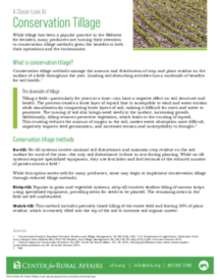While tillage has been a popular practice in the Midwest for decades, many producers are turning their attention to conservation tillage methods given the benefits to both their operations and the environment.
What is conservation tillage?
Conservation tillage methods manage the amount and distribution of crop and plant residue on the surface of a field throughout the year. Limiting soil-disturbing activities has a multitude of benefits for soil health.
The downside of tillage
Tilling a field—particularly for years at a time—can have a negative effect on soil structure and health. The process creates a loose layer of topsoil that is susceptible to wind and water erosion while simultaneously compacting lower layers of soil, making it difficult for roots and water to penetrate. The turning of soil also brings weed seeds to the surface, increasing growth. Additionally, tilling removes protective vegetation, which leads to the crusting of topsoil. This crusting reduces the amount of oxygen in the soil, makes water absorption more difficult, negatively impacts seed germination, and increases erosion and susceptibility to drought.


